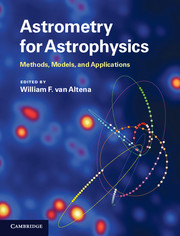Book contents
- Frontmatter
- Contents
- List of contributors
- List of acronyms
- Preface
- Part I Astrometry in the twenty-first century
- Part II Foundations of astrometry and celestial mechanics
- Part III Observing through the atmosphere
- Part IV From detected photons to the celestial sphere
- Part V Applications of astrometry to topics in astrophysics
- 22 Galactic structure astrometry
- 23 Binary and multiple stars
- 24 Binaries: HST, Hipparcos, and Gaia
- 25 Star clusters
- 26 Solar System astrometry
- 27 Extrasolar planets
- 28 Astrometricmeasurement and cosmology
- Index
- References
25 - Star clusters
from Part V - Applications of astrometry to topics in astrophysics
Published online by Cambridge University Press: 05 December 2012
- Frontmatter
- Contents
- List of contributors
- List of acronyms
- Preface
- Part I Astrometry in the twenty-first century
- Part II Foundations of astrometry and celestial mechanics
- Part III Observing through the atmosphere
- Part IV From detected photons to the celestial sphere
- Part V Applications of astrometry to topics in astrophysics
- 22 Galactic structure astrometry
- 23 Binary and multiple stars
- 24 Binaries: HST, Hipparcos, and Gaia
- 25 Star clusters
- 26 Solar System astrometry
- 27 Extrasolar planets
- 28 Astrometricmeasurement and cosmology
- Index
- References
Summary
Introduction
To describe the Milky Way Galaxy, it is convenient to divide the entire collection of Galactic stars into components with broadly consistent properties (e.g. age, chemical composition, kinematics). The main idea behind this division is that those components represent stars of a loosely common origin and, thus, are an important means to understanding the formation and evolution of galaxies. Thus, the Milky Way can be “partitioned” into the four main stellar populations: the young thin and the older thick disks, the old and metal-poor halo, and the old and metal-rich bulge. Each of these populations has its own characteristics such as the size, shape, stellar density distribution, and the internal velocity distribution. The latter can be as low as ˜15 km/s in one coordinate (for the thin disk) and as high as ˜100 km/s (for the halo). It is important to realize that along any direction in our Galaxy, there is always a juxtaposition of these populations, which can be described only in a statistical sense.
Star clusters are another distinct population of objects permeating the entire Galaxy. Our Milky Way Galaxy hosts a large number of recognized open (˜1800) and globular (˜160) clusters that are extremely valuable tracers of the main four Galactic populations. These stellar systems are gravitationally bound and this property along with virtually no dispersion in metallicity and age within an individual system sets them apart from the other Galactic stellar populations.
- Type
- Chapter
- Information
- Astrometry for AstrophysicsMethods, Models, and Applications, pp. 360 - 367Publisher: Cambridge University PressPrint publication year: 2012



